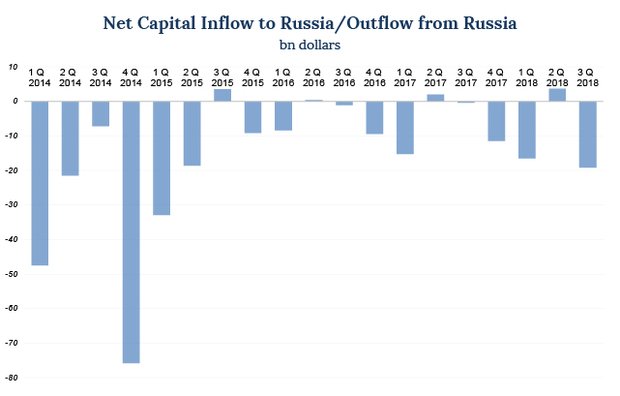Is flow back? Capital outflow from Russia grows 48 times
$19,2bn rubles were withdrawn in July-September, it’s more than in 2016 in total
These days head of Central Bank Elvira Nabiullina had to calm deputies down due to the latest statistics on balance of payments: net capital outflow from Russia rose 48 times in the 3 rd quarter. The private sector withdrew in the three months more than it did than in 2016. Some experts whom Realnoe Vremya asked think this can indicate augmenting problems. But expensive oil is helping at the moment.
Legal outflow
The private sector withdrew $19,2bn from Russia in the 3 rd quarter of 2018 – it's 48 times more than one year ago. It's the biggest quarterly capital outflow since March-June 2015 (see graphic). According to data on balance of payments, banks withdrew $8,8bn in July-September, other sectors withdrew the rest.
After this information appeared in the media, Central Bank Chairwoman Elvira Nabiullina had to calm State Duma deputies down. Giving a speech at a recent plenary session, she explained the concept ''capital outflow'' wasn't equal to illegal import of money from the country.
''We understand capital outflow differently because both currency purchase by the population and holding money in dollars in our banks by our companies is statistically considered as capital outflow. We've always fought against illegal capital outflow, and it's considerably reduced. It's much less in our economy,'' the Central Bank head claimed (quote from RIA Novosti).

Many experts, however, thought Nabiullina's explanation wasn't convincing. It's hardly believed that the population provoked the outflow: if it made a deposit, it's small, economist Sergey Khestanov supposes.
According to him, there were actually two reasons. Firstly, it's accelerated payoff of foreign loans: looking at the uncertainty in the currency market, companies actively try to settle their debts abroad. Secondly, the situation with foreign investments has already affected – year-round direct investments of non-residents fell almost 11 times in nine months: ''This factor is so strong that there are comparisons with 2008 and even 1998.'' Its time coincided with talks about de-dollarisation, which people understand as the refusal of the dollar, not what it means in fact.
 Investment Director at General Invest Denis Gorev links the outflow with bigger sanction-related risks due to which residents reduced the share of ruble assets in their portfolios. In addition, the refusal of non-residents of federal loan bonds made its contribution. The presence of non-residents in the market of federal loan bonds has been reducing for five months in a row: their share has fallen from 34,5% as from 1 April to 26,6% in early September.
Investment Director at General Invest Denis Gorev links the outflow with bigger sanction-related risks due to which residents reduced the share of ruble assets in their portfolios. In addition, the refusal of non-residents of federal loan bonds made its contribution. The presence of non-residents in the market of federal loan bonds has been reducing for five months in a row: their share has fallen from 34,5% as from 1 April to 26,6% in early September.
Market Analysis Department's director at Otkritie Broker Konstantin Bushuyev agrees with Nabiullina. He says residents' grown interest in the currency could have affected the capital outflow statistics. Their purchase of dollars for rubles is formally interpreted as capital outflow, though actually money remains inside the country, he says.
''I agree there was certain growth in demand for the currency. But I think it wasn't the key factor of the capital outflow,'' thinks Alfa-Bank's Chief Economist Natalia Orlova. The private sector really withdrew money from deposits in August. But in Orlova's opinion, only about $2bn could have been spent to purchase the currency, while the outflow exceeds $19bn.
 Perhaps, the exit of investors from the Russian market has played the leading role. For instance, negative moods regarding Sberbank prevailed in July and August. As it became known, there could be imposed sanctions against it. As a result, its shares severely fell, Orlova reminds.
Perhaps, the exit of investors from the Russian market has played the leading role. For instance, negative moods regarding Sberbank prevailed in July and August. As it became known, there could be imposed sanctions against it. As a result, its shares severely fell, Orlova reminds.
Exporters wait for clarification
As Raiffeisenbank's analysts note, the more active capital outflow completely eliminated the positive effect the Central Bank's refusal to purchase the currency for the Finance Ministry had on the ruble (the regulator claimed in September it was ceasing interventions till the end of the year, which significantly supported the Russian currency). The ruble has begun falling against the dollar since last week after a short period of growth.
Analysts write at the same time, Russian companies will likely accumulate liquidity in foreign banks. It can come back to Russia when the sanctions issue becomes clearer.
Moreover, due to high oil prices, Russia's current account's surplus grew by 38% in July-September – to $26,4bn: ''The ruble can notably go down from current levels in such conditions only if strict sanctions are announced or their uncertainty remains, including if Russian exporters reduce the currency inflow to Russia due to softer [currency revenue] repatriation terms. However, in our opinion, the ruble could be a little firmer in the 4 th quarter.''
Sergey Khestanov also notes that Russia's trade balance and account of current transactions, in general, remain positive despite expensive oil: ''This is why the accelerated capital outflow isn't a reason to get into a panic at the moment but rather understand that problems of the Russian economy, including structural, are augmenting. But the income inflow from oil is compensating it in surplus at the moment.''